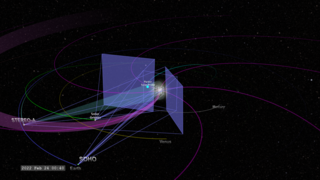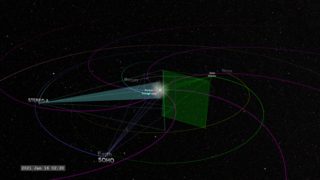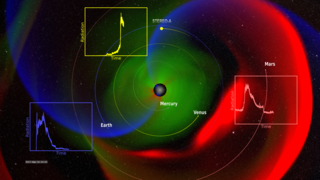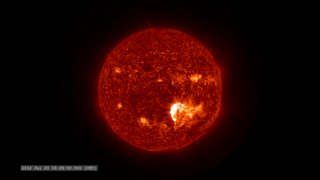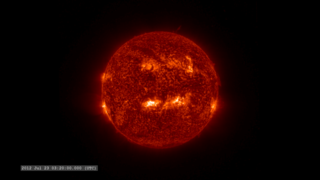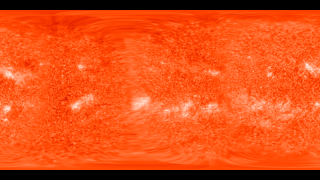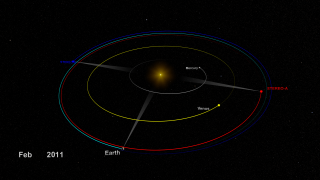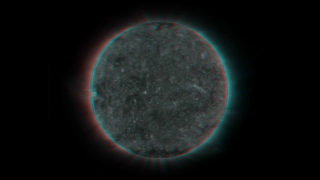Sun
ID: 5136
The Solar Terrestrial Relations Observatory (STEREO) mission was launched on October 25, 2006, with the purpose of tracing the flow of energy and matter from the Sun to Earth. The STEREO mission began with two spacecraft: STEREO-A and STEREO-B. Each was launched into Sun-orbiting trajectories - STEREO-A moving ahead of Earth, and STEREO-B moving behind Earth (STEREO's Routes to Solar Orbits).
In mid-August 2023, the still-operational STEREO-A (STEREO-B went offline in October 2014) will pass Earth for the first time since its launch 17 years ago. Like race cars driving different speeds around a circular track, STEREO-A is traveling slightly faster than Earth around the Sun. After launch, STEREO-A pulled ahead of Earth and extended its lead a little bit more with each orbit. Now, STEREO-A’s lead is so great that it is catching up to Earth from behind and is about to “lap” Earth, having completed 18 circuits around the Sun while Earth completed just 17.
The STEREO mission has accomplished a number of scientific feats, including the following:
1) The first stereo imagery of the Sun with the Extreme UltraViolet Imager (EUVI) instruments
- First 3-D Stereo from STEREO: EUVI 171 Angstroms (Full Disk View)
2) Tracking a coronal mass ejection from the Sun to Earth
- From the Sun to the Earth: CME Enhancement
3) First 360-degree coverage of the solar 'surface'
- STEREO's Ongoing Mission to See the Sun from All Sides
- STEREO+SDO: Around the Sun for 81 Days
- STEREO Achieves Full Solar Coverage: All the Sun. All the Time
4) Multiple views of very large coronal mass ejections
- As Seen by STEREO-A: The Carrington-Class CME of 2012
- As Seen by STEREO-B: The Carrington-Class CME of 2012
5) Identified a dust ring at the orbit of Venus
- Venus Dust Ring
6) Participated in many coordinated observations with other missions
- The CME Heard 'Round the Solar System
- Coordinated Heliosphere - How Solar Missions Work Together
- The Many Eyes on the Parker Solar Probe Perihelion (February 2022)
STEREO-A Returns by Earth
In mid-August 2023, the still-operational STEREO-A (STEREO-B went offline in October 2014) will pass Earth for the first time since its launch 17 years ago. Like race cars driving different speeds around a circular track, STEREO-A is traveling slightly faster than Earth around the Sun. After launch, STEREO-A pulled ahead of Earth and extended its lead a little bit more with each orbit. Now, STEREO-A’s lead is so great that it is catching up to Earth from behind and is about to “lap” Earth, having completed 18 circuits around the Sun while Earth completed just 17.
The STEREO mission has accomplished a number of scientific feats, including the following:
1) The first stereo imagery of the Sun with the Extreme UltraViolet Imager (EUVI) instruments
- First 3-D Stereo from STEREO: EUVI 171 Angstroms (Full Disk View)
2) Tracking a coronal mass ejection from the Sun to Earth
- From the Sun to the Earth: CME Enhancement
3) First 360-degree coverage of the solar 'surface'
- STEREO's Ongoing Mission to See the Sun from All Sides
- STEREO+SDO: Around the Sun for 81 Days
- STEREO Achieves Full Solar Coverage: All the Sun. All the Time
4) Multiple views of very large coronal mass ejections
- As Seen by STEREO-A: The Carrington-Class CME of 2012
- As Seen by STEREO-B: The Carrington-Class CME of 2012
5) Identified a dust ring at the orbit of Venus
- Venus Dust Ring
6) Participated in many coordinated observations with other missions
- The CME Heard 'Round the Solar System
- Coordinated Heliosphere - How Solar Missions Work Together
- The Many Eyes on the Parker Solar Probe Perihelion (February 2022)
Related
Visualization Credits
Tom Bridgman (Global Science and Technology, Inc.): Lead Visualizer
Miles S. Hatfield (Telophase): Writer
Laurence Schuler (ADNET Systems, Inc.): Technical Support
Ian Jones (ADNET Systems, Inc.): Technical Support
Miles S. Hatfield (Telophase): Writer
Laurence Schuler (ADNET Systems, Inc.): Technical Support
Ian Jones (ADNET Systems, Inc.): Technical Support
Please give credit for this item to:
NASA's Scientific Visualization Studio
NASA's Scientific Visualization Studio
Short URL to share this page:
https://svs.gsfc.nasa.gov/5136
Mission:
STEREO
Data Used:
Note: While we identify the data sets used in these visualizations, we do not store any further details nor the data sets themselves on our site.
Keywords:
SVS >> SOHO
SVS >> Orbit
SVS >> Hyperwall
SVS >> SDO
SVS >> Heliophysics
SVS >> STEREO
NASA Science >> Sun
https://svs.gsfc.nasa.gov/5136
Mission:
STEREO
Data Used:
DE 431
Ephemeris - JPL - 2023-06-12T00:00:00 to 2023-10-12T00:00:00
Planetary ephemerides SPICE kernel
Keywords:
SVS >> SOHO
SVS >> Orbit
SVS >> Hyperwall
SVS >> SDO
SVS >> Heliophysics
SVS >> STEREO
NASA Science >> Sun
